The Microsoft Surface Laptop 3 (15-Inch) Review: AMD Ryzen Surface Edition
by Brett Howse on October 21, 2019 9:00 AM EST- Posted in
- Laptops
- AMD
- Microsoft
- Surface
- Ryzen
- Surface Laptop
- Surface Laptop 3
Display Analysis
Microsoft continues to be one of the few PC manufacturers that calibrates all of their device displays, from the lowly Surface Go, all the way to the ultra-expensive Surface Studio range. They’ve also fully embraced the 3:2 aspect ratio for all devices, which initially made their convertible designs better at being convertible, but also makes for a better experience on the Surface Laptop. The Surface Laptop 3 features a 3:2 2496x1664 display, offering a 200 pxiels-per-inch density. With regards to calibration, Microsoft includes a sRGB calibration, as well as the “Enhanced” profile that was first introduced on the Surface Pro a few years ago, which doesn’t stick to sRGB exactly, but provides a bit richer color tones without affecting skin tones.
Microsoft also offers touch and pen support on the Surface Laptop 3. The touch works great, and pen support is also a nice option, although less useful than on something like the Surface Pro where you can use the display as a notebook. The Surface Laptop display only opens about 135°.
To see how the Surface Laptop 3 performs, it was tested with Portrait Display’s CalMAN software suite, along with an X-Rite i1Display Pro colorimeter for brightness and contrast testing, and an X-Rite i1Pro2 spectrophotometer for color accuracy assestment.
Brightness and Contrast
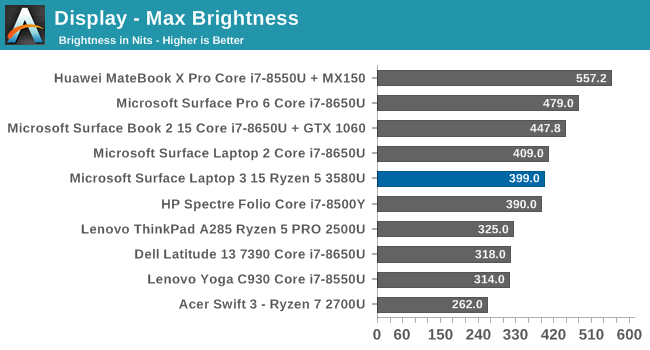
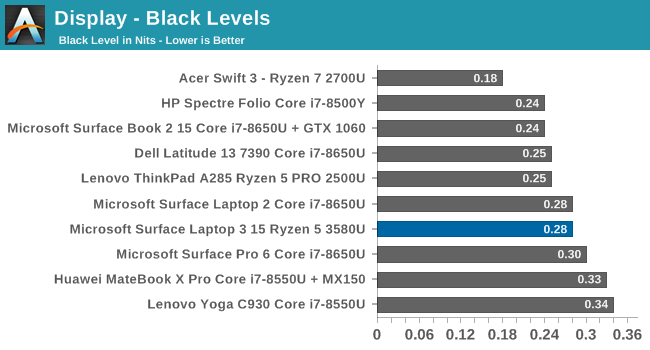
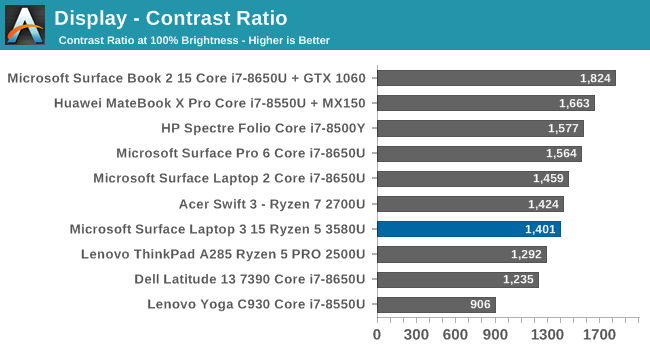
The Surface Laptop 3 gets reasonably bright, with up to about 400 nits of maximum brightness, but still offers great black levels, resulting in a solid 1400:1 contrast ratio. While not quite the contrast of a Surface Book, it’s still a great result. For those that are interested, the display will go all the way down to 4 nits at minimum brightness, so there’s a pretty wide range here.
Grayscale
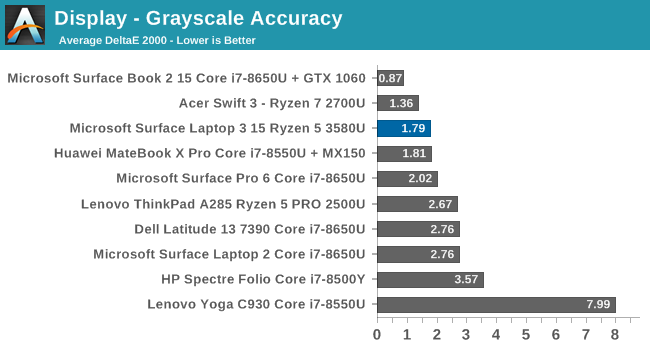
When evaluating grayscale, we’re looking for values under the 3.0 level to be basically imperceptible to the human eye, and the Surface Laptop 3 easily achieves that. At no point during the sweep did any of the gray levels exceed the 3.0 level, which is excellent. The gamma came in close to the 2.2 target as well.
Gamut
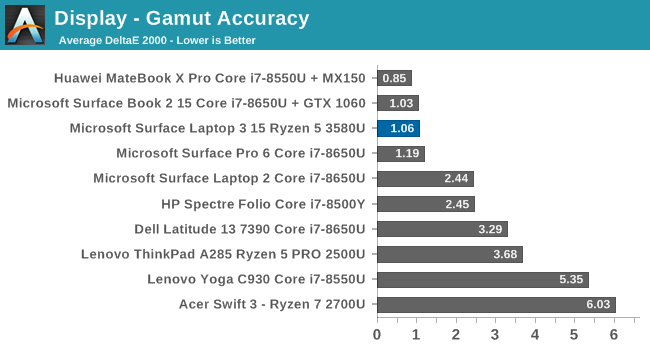
The gamut test highlights the primary and secondary colors at 100% brightness, and the Surface Laptop 3 performs very well here, with all of the colors coming in under an error level of 1.0 and providing full sRGB coverage.
Saturation
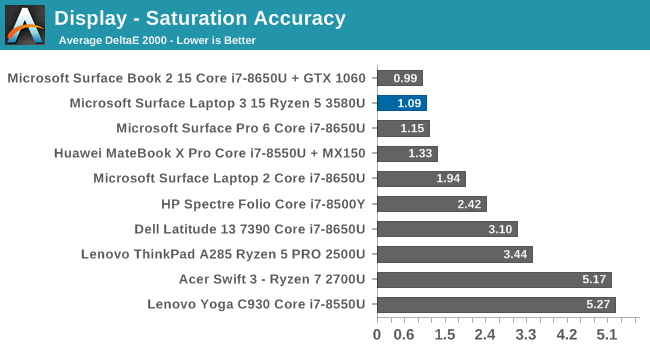
The saturation test is identical to the gamut test, but rather than testing at just 100% levels, the primary and secondary colors are tested in 4-bit steps from 0% all the way to 100%. The Surface Laptop 3 is almost perfect across the entire range, with yellow only being slightly over the 3.0 threshold for the first couple of steps.
Gretag Macbeth
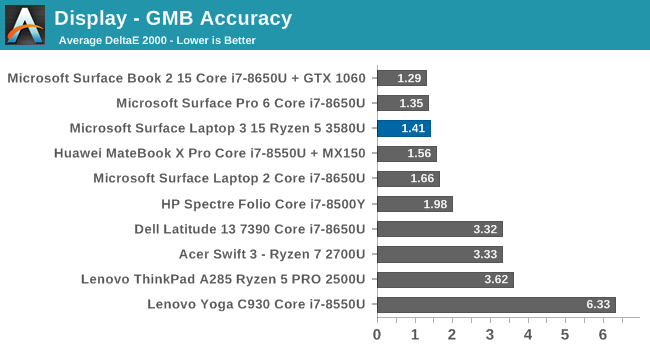
The Gretag Macbeth test expands the tested to color to those well off the primary and secondary color axis, and the Surface Laptop 3 is nearly perfect, with none of the tested colors coming in over the 3.0 limit of perception on the DeltaE 2000.
Display Conclusion
Microsoft continues to set a high bar in terms of displays. The Surface Laptop 3 doesn’t quite offer the resolution of the Surface Book series, but the IGZO display is finely tuned, offering near-perfect color calibration out of the box. Add in both touch and pen support, coupled with the excellent 3:2 aspect ratio, and the result is a delightful display, continuing the Surface tradition. It would be nice to see the Surface team move more towards wider gamut displays, and HDR as well, but until Windows solves its color management issues, that may not be as good of a solution as a properly done sRGB panel.


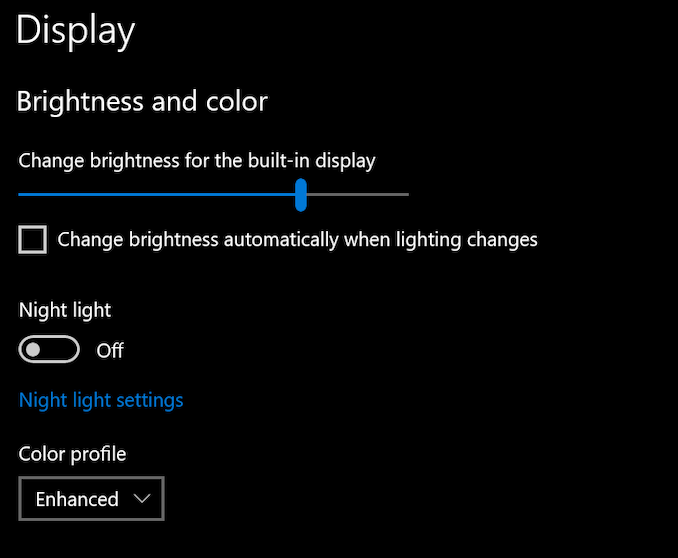












91 Comments
View All Comments
Marlin1975 - Monday, October 21, 2019 - link
For being the base AMD Ryzen model CPU/GPU it performs much better than I though it would. Hopefully you can get a Ryzen 7 version to test soon as well.Rickyxds - Monday, October 21, 2019 - link
The AnandTech is protecting Intel and UHD performance, Why they don't show UHD 630 performance in Rise of the Tomb Raider?they don't show but I will tell you! in the same configuration the UHD 630 offer only 20 fps.
You can search on web the uhd 630 performance on Rise of the Tomb Raider, internet can show!
cyrusfox - Monday, October 21, 2019 - link
UHD 630 is the old Intel GPU(Gen 9.5) found on coffee lake. The new surface has ice lake chips has Gen 11 GPU, Iris plus with 64 EU. Supposedly twice as fast as the prior generation.I am sure we will see cross comparison reviews, especially when someone gets Enterprise 15"(Intel version) to compare straight to consumer 15"(AMD).
justin.anthony.hall - Monday, October 21, 2019 - link
mine is delivered tomorrow, i7 version. I'll let y'all know.mooninite - Monday, October 21, 2019 - link
Early tests of Ice Lake Iris show it is more of the same old junk from Intel. Nothing special. Vega still wins.0ldman79 - Sunday, December 15, 2019 - link
It's just like their previous IGP.Intel brags about "up to 64 EU IGP" then 99% of their SKU have 24 EU or less. One model has 64 EU and that's only their high end i7 K model. Who the hell is going to buy a $600+ CPU and run the IGP? Even if it is Intel's best IGP it's still below a 750 Ti.
Ryan Smith - Monday, October 21, 2019 - link
"Why they don't show UHD 630 performance in Rise of the Tomb Raider?"As you've correctly noted, the short answer is that it's very slow. Too slow to even justify the time benchmarking, unless you like framerates in the teens.
Ultimately the Ryzen APUs are fast enough that we treat them like low-end dGPUs, and that includes running AAA gaming benchmarks on them. The Gen 9.x GT2 GPUs, on the other hand, are decidedly a tier lower for intensive gaming workloads.
Teckk - Monday, October 21, 2019 - link
Good win for AMD not battery life is a bit underwhelming. With the new 1W display for new laptops (based on IceLake?), this needs some serious improvement. AMD needs Ryzen mobile on 7nm soon.A decent laptop but, 128 GB as baseline, really? Good to see they're not offering 4 GB RAM at least. Add another USB port and this is a good enough machine for light home usage.
eastcoast_pete - Monday, October 21, 2019 - link
Thanks for the review! Unfortunately, it confirmed several of my fears - the AMD version of the new Surface is definitely usable, but behind even the previous (Intel) generation of this premium laptop line. The Wifi choices made by MS are indeed questionable at best, while the low battery life points to the basic problem of using a chip not designed for mobile use in an ultraportable. Really wish AMD would roll out a true Zen2+ or better mobile APU with better power management. For now, it continues to play second fiddle to Chipzilla's offerings.GreenReaper - Monday, October 21, 2019 - link
Microsoft is likely to be one of their first customers for this, too... in their consoles. Realistically we'll only start seeing new PCs with equivalent APUs around that time - most likely with 802.11ax Wi-Fi as well in the case of the inevitable Surface Laptop 4.